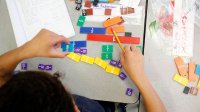My 5th Graders Like Taking Math Tests
By rebranding exams as ‘checkpoints’ and administering them every two weeks, this school has seen a dramatic decrease in testing anxiety.
Your content has been saved!
Go to My Saved Content.I wasn’t the first one to notice it. One of my colleagues who also teaches fifth-grade math commented during our planning meeting, “The students come in and ask whether it’s a checkpoint day, and they are excited when it is!” Excited might be an overstatement, but I had seen it too. Rather than seeming nervous or worried or disappointed, students looked forward to checkpoint days. This was surprising for one obvious reason: Checkpoints are what we used to call tests. Our students were now looking forward to exam day.
From Tests to Checkpoints
Two years ago, we adjusted our assessment schedule from a traditional model with a test at the end of every unit to giving slightly smaller assessments every two weeks or so. Rather than testing only the current material, each “checkpoint” includes both current and past topics with a fair amount of repetition, especially for the most important skills. In class, we often tackle large, difficult ideas. The purpose of the checkpoint isn’t to provide the opportunity to stretch. We give students lots of chances to do that elsewhere. Instead, it is about showing that students are mastering key content.
Giving checkpoints every two weeks freed us from having to time our tests around finishing specific content. We would go through all kinds of contortions to finish a unit before a break or on a Thursday so that we could give the test at the right time.
More important, our primary goal was to provide more feedback and to gain more opportunities to see progress. We were experimenting with incorporating more retrieval practice into our classes, following up on what we had learned from resources like Make It Stick and Retrieval Practice. These resources encourage using tests and quizzes as learning instead of simply seeing them as assessment of learning.
The idea is that having lots of opportunities to remember an idea or to practice a skill strengthens the memory. Tests become chances to strengthen memory, an inherently beneficial activity aside from whatever the teachers might learn from it. Instead of an exam, which wasted valuable class time, these checkpoints provided needed practice to students. Every two weeks, we got a period of sustained, focused work from pretty much every student. It seemed to be working.
Student Buy-In
Although we anticipated a positive shift in learning, my team didn’t expect that the students themselves would see it as a positive change in practice. The biggest difference between our old tests and the checkpoints is a marked reduction in student stress levels. We don’t see the same anxiety we often saw on our previous math tests. The tests are given frequently and predictably. They share a consistent format, which may also improve the student comfort level.
We spend a lot of time in fifth grade trying to foster a positive environment. We begin the year with establishing our math community standards, and we encourage a growth mindset about mistakes. We even have a “favorite mistakes” month, where all of us, including the teachers, share where we goofed up and acknowledge that we all do. But performance anxiety persists, and students often use tests to judge themselves harshly. You could see it in the way they erased furiously when they weren’t sure or sat staring sadly at the page as if an answer might magically appear. I’m seeing fewer skipped problems and a decrease in “IDKs” where the answer should be. Checkpoint days aren’t a party, but I’m not seeing the same frustration.
Assessment
Importantly, we also changed the way these assignments were assessed. We don’t score the checkpoints like tests. There is no percentage correct given or grade attached. We do mark where students make mistakes and write comments that we hope will be helpful when students correct their work. We ask students to go back and revise their work based on our comments. Similar problems reappear on future checkpoints, so students get a chance to learn from revision.
A student might miss a concept the first, second, and sometimes even a third time they see it. However, if they are later able to demonstrate the skill consistently, we count only their current proficiency. This gives them time to improve without penalty. Our school does not assign letter grades at this age level, but if I needed to give grades, this approach fits well with a standards-based approach and would adapt easily to rubric scoring.
More than anything, giving a checkpoint in the same style every two weeks normalizes the idea of pausing and taking time to see where we are and what we need to work on more. Because checkpoints are a mix of both new and older material, students are able to answer most of the questions pretty easily, which fosters a sense of accomplishment.
I think the student acceptance of the frequent checkpoints is probably mostly about that sense of competence. Rather than focusing on what students can’t do, it celebrates what they have achieved. And why wouldn’t a student look forward to that?
